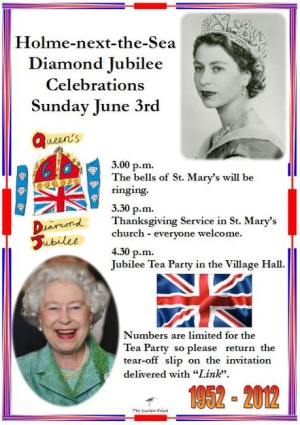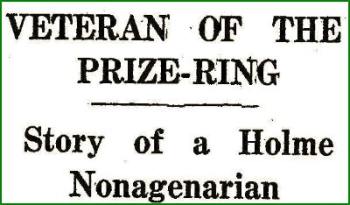Gallery items before 2015
A Sunfish on the beach!
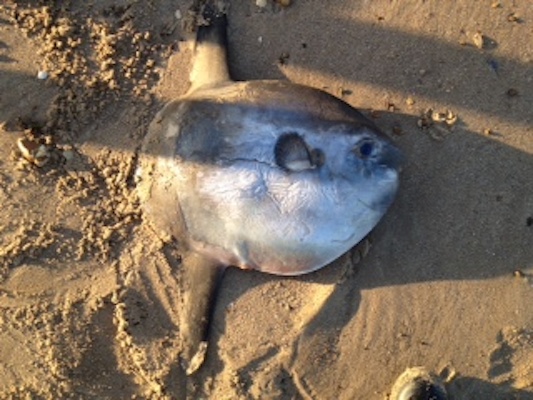
On a bright and crisp New Year's Eve, 2014 Jeremy Colston, a visitor from Claypole near Newark, was enjoying a walk on the beach here at Holme-next-the-Sea when he
came across this strange looking fish washed up near the shoreline.
It is a rather small Ocean Sunfish (Mola mola). Although more often found in warmer waters they are being seen more frequently around our coast. Many thanks to
Jeremy for reporting the find and sending the photo.
Lots more information about Sunfish at Wikipedia.
The Church Fête, 2014
In 2014 we were blessed with fine weather on the day of the fête in contrast with some rather nasty days either side. We were lucky!
Once again, there were many stalls, and especially lots of games for the young - and the young at heart...
Jan Foster managed to take a few moments out from selling cakes (which sold like, well hot cakes) to take some photos. Click on the thumbnails to see larger
pictures...
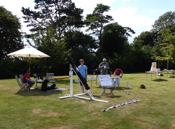
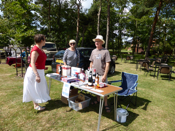


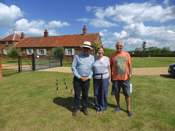

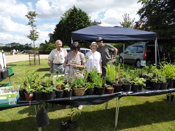

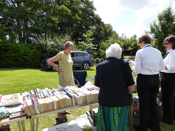




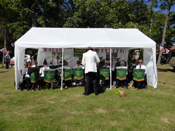
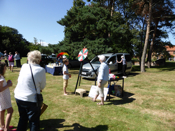
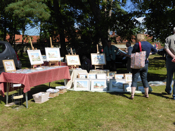
Flood defence work at the golf course crossing
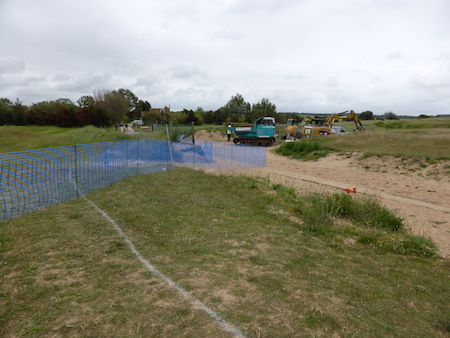
Monday 16th June, 2014 saw the start of work to erect a bund across the access path which leads to the beach via the golf course. The work is being carried out
by the Environment Agency and it is hoped that that it will help to avoid a repetition of the flooding that occurred during the tidal surge experienced in December, 2013
when water flowed around Gore Point, through Lavender Marsh and then across the golf course and into Beach Road.
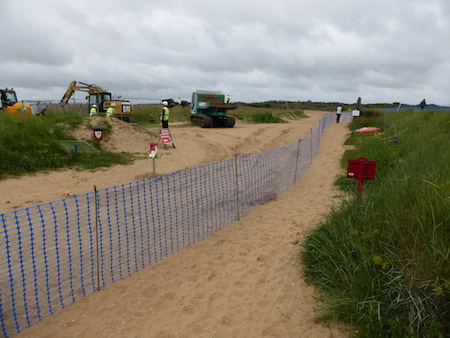
The raised area will be covered with imported clay (probably 300-400 tonnes) and then finished with a mesh to help the establishment of grass and wild flowers and
plants.
Whilst the work is in progress the foothpath that crosses the golf course will be temporarily restricted in width. The machine operators are aware that horses cross here and
will stop machinery when horses are about to cross.
After the work is complete, the access to the beach across the golf course will be just the same as it was before - but with the addition of a small embankment across
the path.
Clearing rubbish from the beach
after the tidal surge
Following an appeal by parisioners Robin and Jane, some of the villagers turned out to help remove flotsam and other debris deposited on the beach and the Lavender
Marsh during the tidal surge and high flood waters that hit the village during the late evening of December 5th, 2013. A skip was provided by the Environment Agency and
here's a glimpse of just some of the rubbish collected.
Click on these thumbnails to see larger pictures...
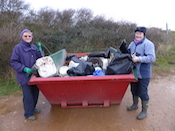

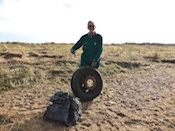
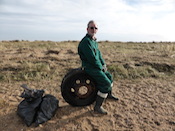

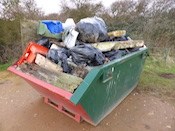
In the afternoon of the 25th January, 2014 it is reported that about 30 people were out on the beach and the Lavender Marsh in a concerted effort to remove even
more of the rubbish. With grateful thanks to all the villagers, and friends from other villages, who have taken part in this litter clean-up and not just those shown in the
photos above!
If you are walking on the beach or doggy-walking there please do take a bag and bring home a few bits and pieces of any rubbish you may find spoiling the beach
and marsh - perhaps not the wheels and tyres though, unless you really want the exercise! Every little helps...
The final photo above shows just what was achieved with some excellent team work and community spirit...
High winds bring down a power line
On Monday 30th December, 2013 high winds caused a power line to break resulting in a loss of power for four hours to parts of the village. The pole
that suffered damage is to the east of the manége (area for training/schooling horses) off Beach Road just south of the bridge over the River Hun.

Flooding in the parish of Holme-next-the-Sea
In early December, 2013 the Environment Agency correctly predicted a tidal surge along many parts of the Norfolk coast after gale force winds accompanied by a high
tide.
At Holme-next-the-Sea, late in the evening of Thursday 5th December 2013, the sea broke through near Gore point, flowed across the Lavender Marsh, onto the golf course
crossing and into Beach Road. The water came within about 15m of the north side of the bridge across the River Hun. There was also erosion caused to the dunes near the
N.W.T. Visitor Centre and many other locations around the Norfolk coast also suffered flooding in varying degrees of severity.
Our thoughts are with all those who suffered water damage to their properties and posessions.
Click on these thumbnails to see larger pictures...
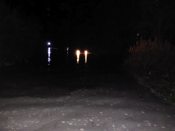
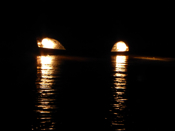
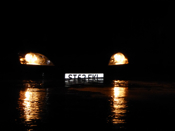

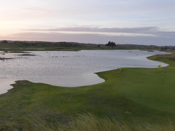

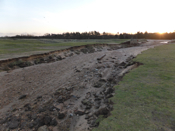
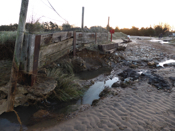
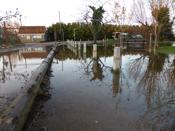
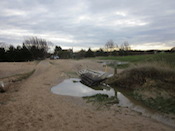
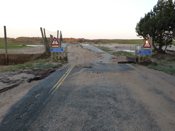
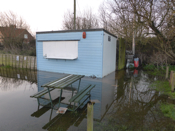


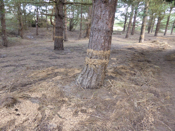
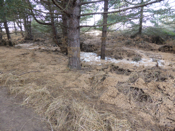
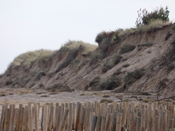


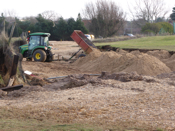

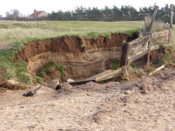
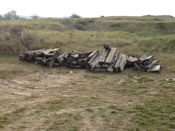
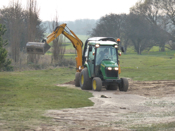
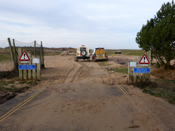

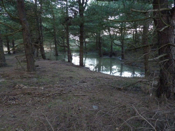
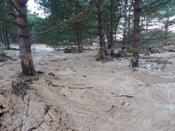
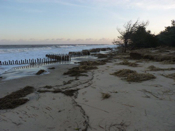
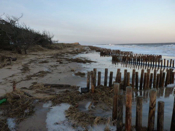
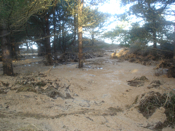
Sparrowhawk pops in for a wash and brush up
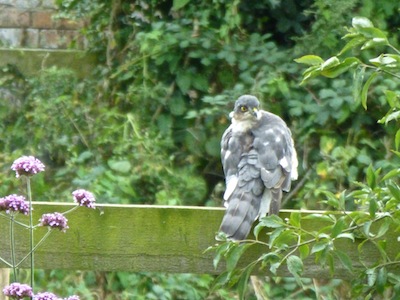
On September 8th, 2013 this juvenile Sparrowhawk sat preening and cleaning itself on our our back fence in a village garden - it appeared to have recently
bathed, perhaps in our pond.
The bird remained alert and only stayed for 3 or 4 minutes. Coincidentally, all the other garden birds disappeared whilst this youngster was around -
can't think why!
'Tis the season for Brown Hares…
The European, or Brown, Hare likes to be seen during the early Spring when the sap starts to rise. Malcolm Pitt was in one of the NWT hides on Holme Marshes when
he had a rare opportunity to see a hare swimming. Fortunately he had his camera and has kindly provided us with this splendid group of photos.
Click on these thumbnails to see larger pictures...
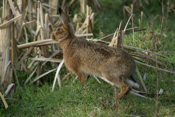
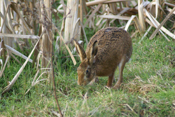

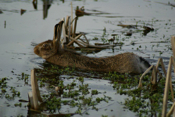
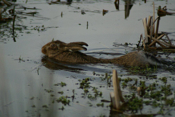
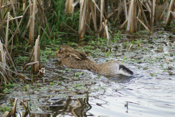

Big bangs blast beach!
During the last week of November, 2012 residents of Holme-next-the-Sea were hearing occasional loud explosions coming from the general area of the beach. Some villagers reported their windows rattled and others rushed to check that their central heating boilers were still functioning normally!
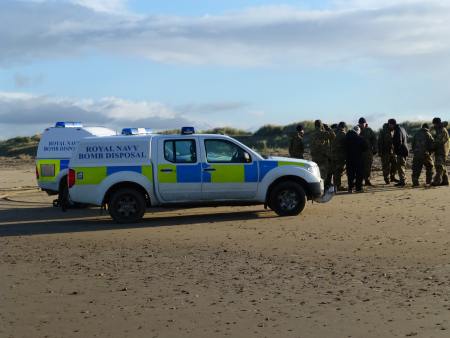
During the last world war, and in the decade that followed, there were army firing ranges located in the area. To make
the practice more realistic tracks were built to allow mobile targets to traverse to and fro so that the gunners would be
more realistically challenged. Not all of the ordnance fell where it was supposed to and a number of rounds, of various
sizes, found their way on to the local beaches.
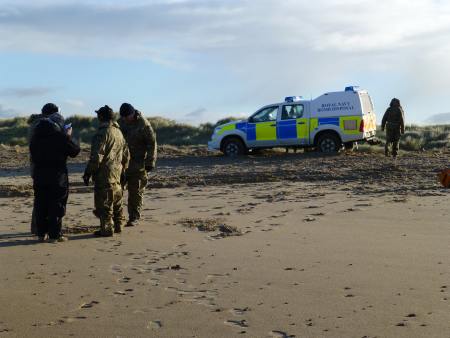
Every year one of the forces' bomb disposal teams send in detection experts to search for buried metal objects on the
beach. Any locations are marked with a flag and shortly afterwards a bomb disposal team arrives to dig up the discovered
metal to check if it is ordnance. If anything potentially dangerous is discovered it is demolished with a controlled
explosion - the big bangs.

This year a team from Royal Navy Diving Unit 2 visited Holme-next-the-Sea to look after the demolition jobs. A big thank you to to all those who are helping to clear our beaches of these unexploded shells.
The Heacham Deanery Magazine
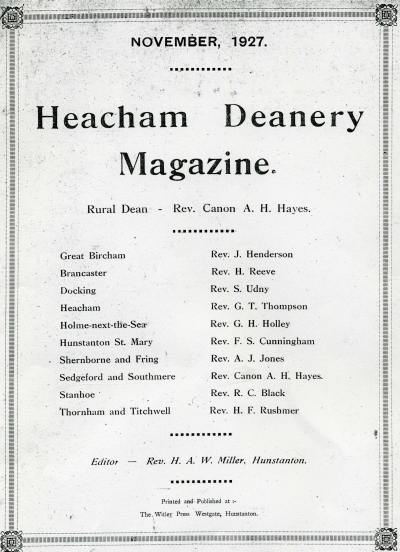
Robert Jones, a villager, was given a number of copies of the Heacham Deanery Magazine dating back to the 1920s.
The following extracts concern everyday matters in the village of Holme-next-the-Sea and provide a fascinating insight into parish life
at that time.
Just click on these links to peer through a window into the past...
The title page of the Heacham Deanery magazine dated April, 1925.
Extracts from April, 1925; August, 1926; April, 1927 and November, 1927.
Extracts from September, 1934; March, 1936; October 1936 and November, 1936.
Extracts from December, 1936; October, 1939 and November, 1939.
Extracts from April, 1940 and January, 1941.
Heavy rain causes a torrent in Chalk Pit Road
On Thursday 21st June, 2012 a torrential downpour during the day caused water to wash soil off of the potato field up Chalk Pit Road
leading to a flood of muddy water which flowed down the road, across the A149 right down to the end of Eastgate. These pictures were taken
by the late Trevor Arnold who lived in Chalk Pit Road.
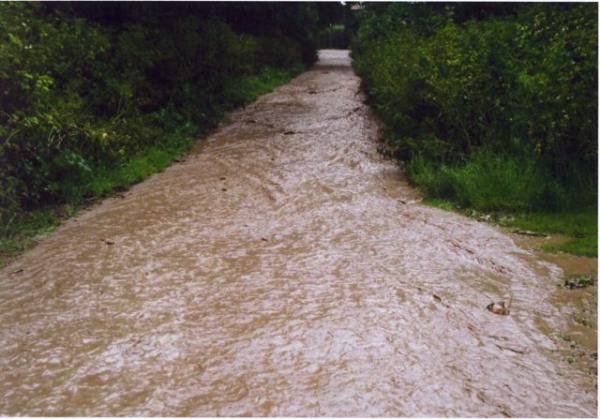
Chalk Pit Road looking north towards the A149 - 21st June, 2012
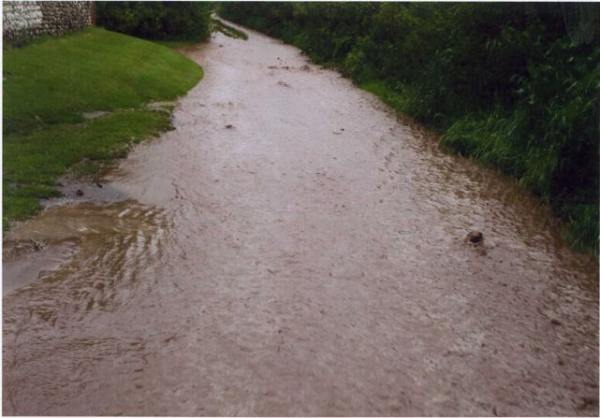
Chalk Pit Road looking south towards the fields - 21st June, 2012
The Diamond Jubilee celebrations
Postcard from Norfolk
The following 'postcard' was written on October 7th, 2011 by MacNabbs - "Gentleman and Player"! He posted it on his blog page at Postcard from Norfolk and has very kindly allowed the item to be reproduced here...
"Lying in bed, in the dark, sensations, and fears, are somewhat magnified. As once wisely stated by Bill Watterson, night time is dark to allow you to worry without distraction. My particular concern last night was that the cottage was going to blow over. While the wind did
not quite howl and shriek like a banshee (I understand Irish cottages have the monopoly on that) it did moan like a sulky teen, and there was
the occasional high pitch whine as a gust picked at the vents in the double glazing.
I was wondering for a few moments if this was the Norfolk version of the end of the world. This is an area famous for flooding and a stiff
onshore breeze combined with a high tide can be trouble. Luckily, despite the darkness and the holiday quantities of wine I had taken on board,
I was able to make the connection between the view directly out to sea, the exposed position and all of the sentinel wind farms dotted around the
horizon and realise that this was, in fact, situation normal.
The only excitement came when, from the bathroom, came a noise exactly like little mouse claws scrabbling on the sides of the bath. Oh no!
Scrabble scrabble! Upgrade from mouse to rat. Scrabble SCRABBLE! Crikey, sounds like an otter. SCRABBLE SCRABBLE! Badger, there's a badger
in the bath! I sprang into action, ready to set to with a brush or mop or whatever it is that badgers are intimidated by.
Putting on the light, convinced that something was in the bath, I was surprised to see it empty. Oh no! The badger is out! Then rain-pitter
pattering against the velux window with, in my defence, exactly the sound of a scrabbling rodent, solved the mystery. All that remained was
to head back to bed and wait for my heart rate to return to normal. This took until dawn.
The next day was ideal for a stroll round the village. Holme-next-the-Sea qualifies as a village because it has the trinity of village
requirements, pub, post box and telephone box. Oh, and a church.
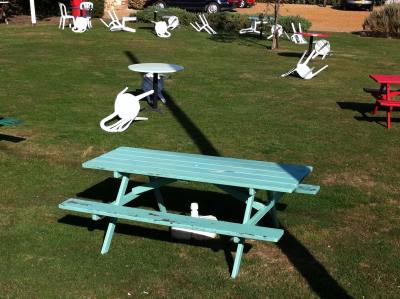
The church was in fact rather lively, it was reached by walking past the pub's garden, where the winds of last night had redistributed the gaily
coloured plastic patio furniture on the green grass in quite an attractive fashion.

We were all set to take a look inside the church when the Wedding March struck up, and then the bells began to peal, and then the bride and groom
exited the church! It was a fabulous day for a wedding and everyone looked very pleased and excited, just as wedding parties should.
Wandering along the lane, we heard behind us the distant buzz of a scooter, turning, we were confronted by the vicar astride his moped, crash
helmet on and cassock billowing as he sped past at a mighty twenty miles an hour. From the look of expectant determination on his face one can
conclude that nothing gives a priest a thirst quite like a wedding.
Looping back to take a look at the now empty and rather gorgeous church, I hit upon a realisation - if you are going to get married, make sure you
do it at Harvest Festival time, because the church looks fabulous. As long as you don't mind the odd vegetable wound into the flower
arrangements, you won't have to worry about anything apart from bouquet and buttonholes, and if you make sure your florist knows to weave some
barley into the arrangements, you'll co-ordinate beautifully and save yourself a fortune.
If you do need fruit, it's available from many of the roadside stalls that line the roads in the village. Many of them have little roofs to keep
the worst of the elements off and remind one a little of those roadside shrines that one sees in Greece, except they lean less to candles and
rather more to honesty boxes made of Tupperware and cox's pippins in plastic bags."
Snow scenes

During the late evening of Saturday 4th February 2012, and for a while overnight, Holme-next-the-Sea (as well as many other parts of the country)
saw a steady fall of snow and, with the aid of a stiff breeze, there was considerable drifting in places. This picture is taken from the top
of St. Mary's church tower looking west with the Village Hall on the right.
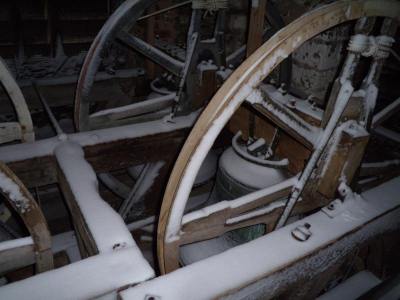
The snow also found its way in through the louvres of the belfry of the church tower. The bells and fittings have taken on a rather
Christmassy appearance - however when the largest bell was first rung for Sunday service there was an accompanying flurry of snow down
in the ringing room!
Egyptian Geese on the roof of St. Mary's church

During January, 2012 two Egyptian Geese have become regular visitors to St. Mary's church! This goose is in the Shelduck subspecies of
the duck, goose and swan family Anatidae and is a largely terrestrial species readily perching on trees and buildings. This pair seem to enjoy
loafing around on the ridge of the church's main roof. (Village artist Wendy Long kindly provided this picture.)
Whale washed up at Old Hunstanton

On Christmas Eve, 2011 a 55ft Sperm Whale was washed up dead on the beach at Old Hunstanton close to the Life Boat Station. It is believed
that the mammal died at sea from injuries sustained to the stomach.

Large crowds gathered over the Christmas holiday period to see the whale and sadly the animal's teeth were soon being removed by souvenir
collectors. Initial reports declared that the whale would be left on the beach to be swept away by the tide but later there was news that
it would be removed by a local haulage company.
Tree felling in St. Mary's churchyard

During the summer of 2011 a heavy bough broke away from the large beech tree in the churchyard of St. Mary's.
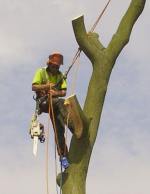
Fortunately it fell away from Church Cottages and into the churchyard without causing damage. The P.C.C. arranged for a 'tree surgeon' to inspect the beech and his verdict was that severe rot had set in where the three main trunks met and that further collapse was possible in the future. So a decision was made to cut the tree down to a safe size - work started on the 4th July, 2011 and was completed soon after that. (Many thanks for the photos taken by Peter Fynn, a regular visitor to Holme-next-the-Sea for the last 20 years or so.)
Himalayan Balsam
The River Hun flows west to east through the parish bordering Broadwater Road for part of its journey down to the sea. In about 2009 a pretty pink flower appeared
along its banks, especially around the area of the Norfolk Ornithologists' Association's hide on Redwell Marsh.
Pretty it may be but it is a non-native species Impatiens Glandulifera known by a variety of common names - Policeman's Helmet, Bobby Tops, Copper Tops, Gnome's Hatstand
and Kiss-me-on-the-mountain but by far the most popular name is Himalayan Balsam - and it is very invasive!
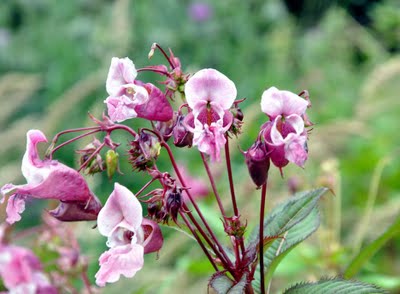 It typically grows to 1 to 2 m (3.3 to 6.5 ft) high, with a soft green or red-tinged stem, and lanceolate leaves 5 to 23 cm (2 to 9 in) long. The crushed foliage has a strong
musty smell. The flowers are pink, with a hooded shape, 3 to 4 cm (1¼ to 1½ in) tall and 2 cm (¾ in) broad; the flower shape has been compared to a policeman's
helmet, giving rise to the alternative common name Policeman's Helmet. Although it does not range all over India and is by no means the only Impatiens native to that country,
it is also known as Indian Balsam in countries where it is introduced.
It typically grows to 1 to 2 m (3.3 to 6.5 ft) high, with a soft green or red-tinged stem, and lanceolate leaves 5 to 23 cm (2 to 9 in) long. The crushed foliage has a strong
musty smell. The flowers are pink, with a hooded shape, 3 to 4 cm (1¼ to 1½ in) tall and 2 cm (¾ in) broad; the flower shape has been compared to a policeman's
helmet, giving rise to the alternative common name Policeman's Helmet. Although it does not range all over India and is by no means the only Impatiens native to that country,
it is also known as Indian Balsam in countries where it is introduced.
After flowering between June and October, the plant forms seed pods 2 to 3 cm (¾ to 1¼ in) long and 8 mm broad (¼ in), which explode when disturbed, scattering
the seeds up to 7 meters (23 ft). Impatiens, meaning "impatient", refers to this method of dispersal.
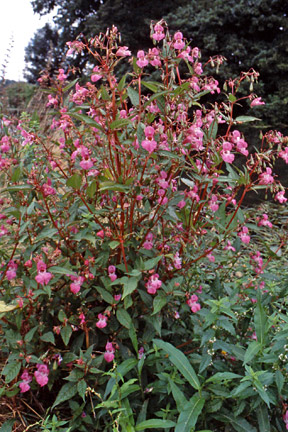
Himalayan Balsam is sometimes cultivated for its flowers. It is now widely established in other parts of the world (such as the British Isles and the United States), in some
cases becoming an invasive species weed. The aggressive seed dispersal, coupled with high nectar production which attracts pollinators, often allows the Himalayan Balsam to
outcompete native plants. In the UK the plant was first introduced in 1839 at the same time as Giant Hogweed and Japanese Knotweed. These plants were all promoted at the time
as having the virtues of "herculean proportions" and "splendid invasiveness" which meant that ordinary people could buy them for the cost of a packet of seeds to rival the
expensive orchids grown in the greenhouses of the rich. Within ten years, however, Himalayan Balsam had esaped from the confines of cultivation and began to spread along the
river systems of England. Today it has spread across most of the UK and some local wildlife trusts organise "balsam bashing" events to help control the plant.
(Thanks to Wikipedia for some of the technical info...)
Peggotty's Cottage

In either 1986 or 1988 (depending on which source you use) a film adaptation of "David Copperfield" by Charles Dickens saw the erection of Peggotty's Cottage on the beach at Holme-next-the-Sea.
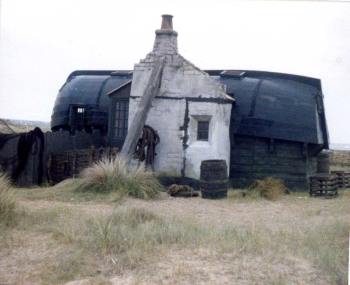
We understand that there was also a temporary aluminium surfaced road laid down to the beach for the film equipment - but information is sketchy.
Wendy Long, a resident of the village, took these pictures...
Water Vole
"Ratty" in Kenneth Grahame's Wind in the Willows was, of course, a water vole (Arvicola amphibius) and not a rat. During the early part of June, 2011 at least
three water voles were seen in the River Hun just north of Redwell Marsh at Holme-next-the-Sea. One of the animals was seen carrying a young water vole in its mouth.
Water voles have rounder noses than rats, deep brown fur, chubby faces and short fuzzy ears; unlike rats their tails, paws and ears are covered with hair. They mainly eat grass and
plants near the water. At times, they will also consume fruits, bulbs, twigs, buds, and roots.
The mating period lasts from March into late autumn. The female vole's pregnancy lasts for approximately 21 days. Up to 8 baby voles can be born, each weighing around 10 grams
(0.4 oz). The young voles open their eyes three days after their birth. They are half the size of a full grown water vole by the time they are weaned.
Water voles are expert swimmers and divers. They do not usually live in large groups and in the wild, they survive for 2 years on average; most do not survive a second winter.
Click on these thumbnails to see larger pictures...
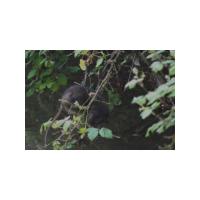
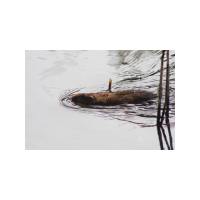
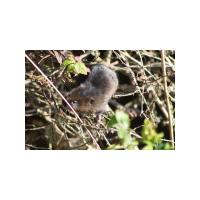
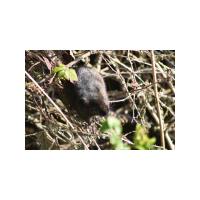
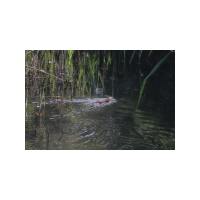
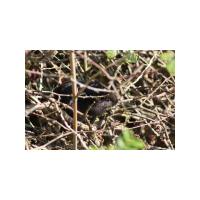
A resident Little Owl

This picture of a Little Owl was taken by village resident Gill Morley who has been observing the bird for several weeks
during the Spring of 2011.
This rather small owl was introduced to the UK in the 19th century. Favoured locations are hedges, copses, parks, orchards and lowland farmland. Unlike some owls
it is often seen in daylight usually perched on a tree branch - just like this one! When alarmed the bird bobs its head up and down. It flies with rapid wingbeats
on long, rounded wings and with a slight undulation. This species of owl tends to hunt at night and dawn eating small birds and mammals, worms and beetles.
Konik ponies
You may be lucky enough to spot some ponies roaming the marshland between village of Holme-next-the-Sea and the sea. Norfolk Wildlife Trust has introduced a
small herd (about a dozen at the last count) of Konik ponies, a primitive Polish breed. They are ideally suited to wetland conditions and help control the growth
of scrub by grazing and this will lead to improvements in the habitat for breeding birds.
If you do get close to the ponies please do not feed them and do respect their personal space. They live in the wild and require no additional food treats!
Wendy Long, a resident artist in the village, has been busy with her camera and took these photos of some of the herd individuals.
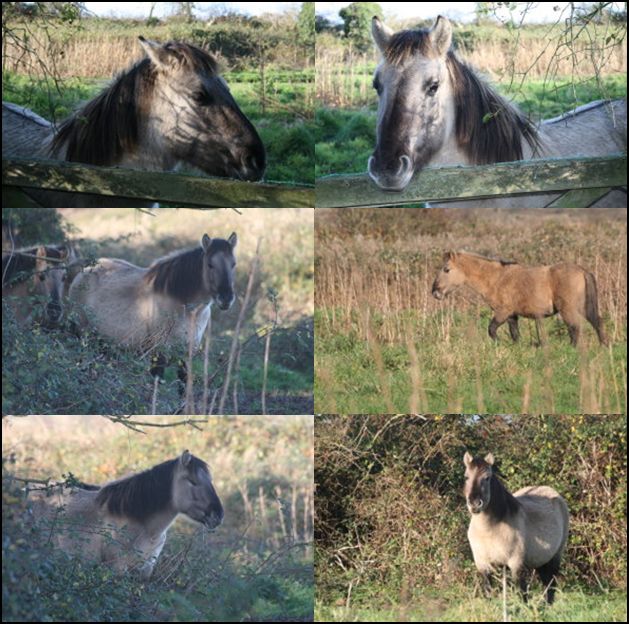
A Blackbird's story
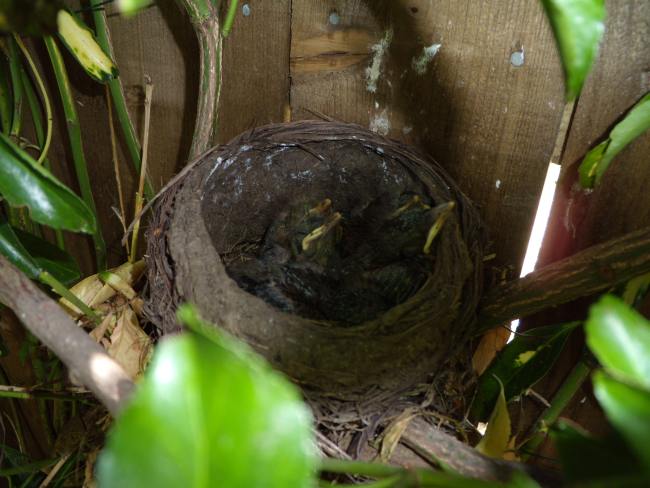
In a garden on Westgate a pair of Blackbirds are cutting down like the rest of us in the current economic downturn. They have re-used their nest for a
second brood. Here are the four chicks, all doing well, after Mum and Dad's second go at raising a family this year! The first time around at least three
birds fledged so fingers crossed they will be successful again. (Happy to report that, a week or so later all the young fledged successfully!)
Rogation Sunday
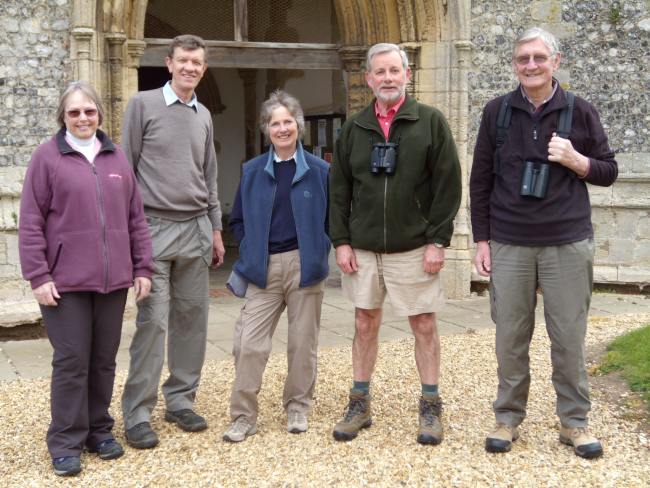
From left to right: Jill Bowett, Roger Davey, Hilary Davey, Tony Foster, David Bowett
The fifth Sunday after Easter is called Rogation Sunday, the start of Rogationtide which ends on Ascension Day, the final appearance of Christ. "Beating the Bounds"
is a custom originating from Anglo-Saxon times when parishioners walked the entire boundary of the parish. One of the main reasons for this yearly perambulation was
for the clergy representatives to ask for (rogare = beseech) the divine blessing upon the parish lands for the ensuing harvest. The walk also ensured that evidence
of the boundaries of the parish might be reaffirmed and preserved. These days, surveyors with their theodolites help keep everything in order. Nevertheless, many
parishes still use Rogation Sunday as an excuse for a jolly good walk whilst enjoying the companionship of others in the community and not least to make some mark
in the history of the parish that says, "We were here and the parish was here too!" A bonus for us in Holme-next-the-Sea are the fantastic views of the church and the
North Sea beyond from the high point above Ringstead and also the final leg along the North Coast Path National Trail as the Beaters of Bounds complete the circuit.
This year, 2010, Hilary organised the walk which took place on May 9th and afterwards Roger and Hilary very kindly invited the walkers back to The Spinney for tea and cake -
an excellent way to finish a most enjoyable walk!.
James Ellender
Mr. James Ellender, an almost legendary character, lived at Beach House, Beach Road, Holme-next-the-Sea until 1941. His death was reported in
the Lynn Advertiser and we are fortunate to have obtained a clipping detailing his story. Click on the headline to read all about it!
Flower arrangements in St. Mary's Church
Click on the flower arrangement for lots of pictures of the Flower Displays throughout the year in St. Mary's Church.
Sunset from Westgate
Four views of a sunset taken from Westgate on 8th January, 2010
(Photos by Roger Davey).

On the Village Green
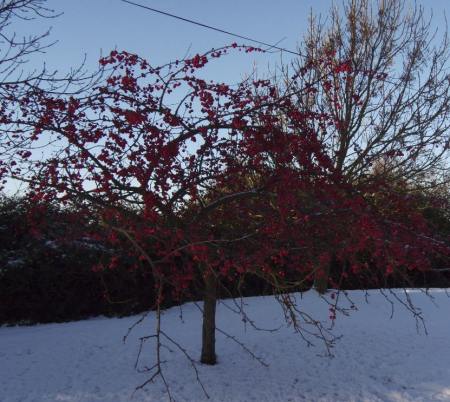
The Crabapple tree on the village green looking rather splendid against a backdrop of snow - December 2009...
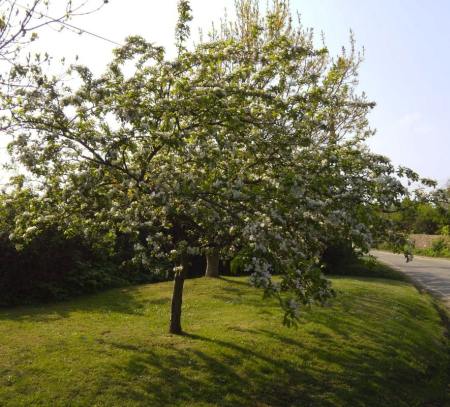
...and as the seasons change we see the same tree, now full of blossom, on a beautiful Spring day in May, 2010.
Amazing how just one tree can lift the spirits!
Carol singing
Village carol singers raising money for The Norfolk Hospice, Tapping House.
Here they have just come to the end of the evening's walk around the village
and are singing for their supper at the last house!
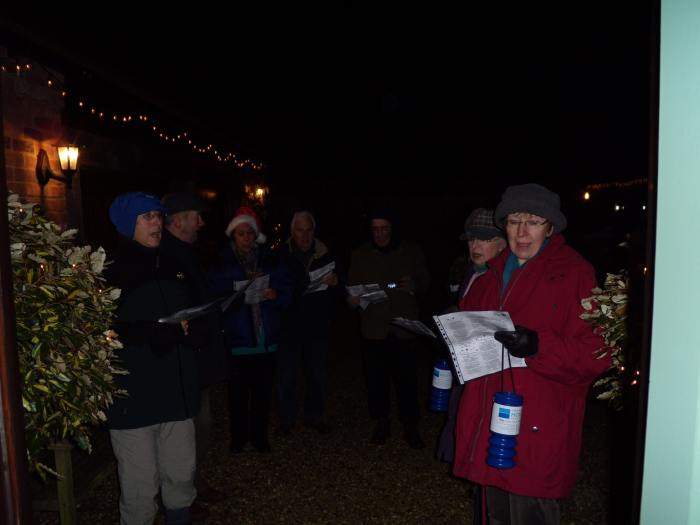
Muntjac deer

Muntjac Deer, also known as "barking deer", are sometimes seen around the village. This female was snapped looking very much at home in a garden on Westgate.
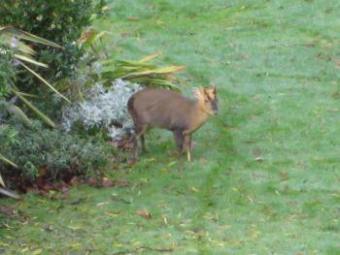
Sunrise from Westgate
Sunrise from Westgate - 19th November, 2009

Haybales with attitude!
Hay bales stored for the winter watch the world go by...
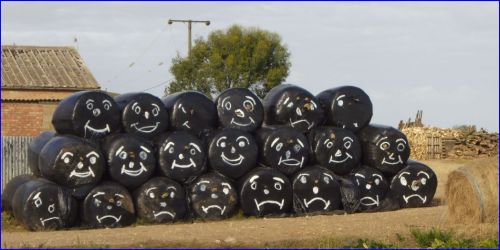
A visitor's poem
Mr. Roy Speirs, a regular visitor to the village, has written the following poem...
CHAPEL COTTAGES
Holme from home, it is for me,
That is, Holme-next-the-Sea,
In a cottage small with stable door,
Large square tiles compliment the floor,
Full timbered beams the ceiling shows,
While warm air upstairs freely flows
To spacious bedroom extremely neat,
A perfect, ideal holiday retreat.
And a hooting owl is faintly heard,
Through open window somewhat blurred,
While the ever present murmuring sea,
Provides the background melody.
The winding stairs how well they blend,
With helpful handrail to ascend,
To bathroom large enough for two,
For aching limbs to sink into.
Relax and think of the White Horse pub,
With splendid ale, and home-cooked grub.
Full open fire, fit for a king,
Plus cheerful welcome from all within.
No need for a holiday abroad,
For here's a place you can't be bored.
It's quaint old English village street,
Has no pavement for your walking feet.
And stone-built cottages with pantile roof,
All justify the planners' proof.
This unspoilt village built to last,
Modern, yet conveys the past.
While birds sing out from every tree,
Yes, Holme from home is the place to be.
About the author...
Roy William Speirs, born lst April, 1932 in Buwell, Nottingham, is an amateur naturalist, match angler, eel fisherman, birdwatcher, sportsman, retired fireman,
admirer of natural beauty in all its forms and a lover of the English countryside. He's a member of the Royal Society for Protection of Birds, Nottinghamshire Wild
Life Trust, Nottingham Anglers' Association and the British Hedgehog Preservation Society. He was urged by friends to put his collection of poems into print. Most
were written after retirement from the Nottingham City Brigade. This book is the result. First published in 2008 when the author was aged 76.
Copies of this book are available from R W Speirs, 2 Langdown Close, Bulwell, Nottingham NG6 8JE. Price £6, plus £1.50 postage and packaging (UK only). If required
abroad, the cost of postage and packaging is £3.50. Copies will be signed by the author if requested.
Railway chatter
Many folk have mourned the passing of the King's Lynn to Hunstanton railway line. Here is a trip down memory lane, courtesy of the Dailymotion website to whom
we extend thanks for this link.
This is a real gem with a narration by the late Sir John Betjeman who died in 1984 and who was the Poet Laureate .


